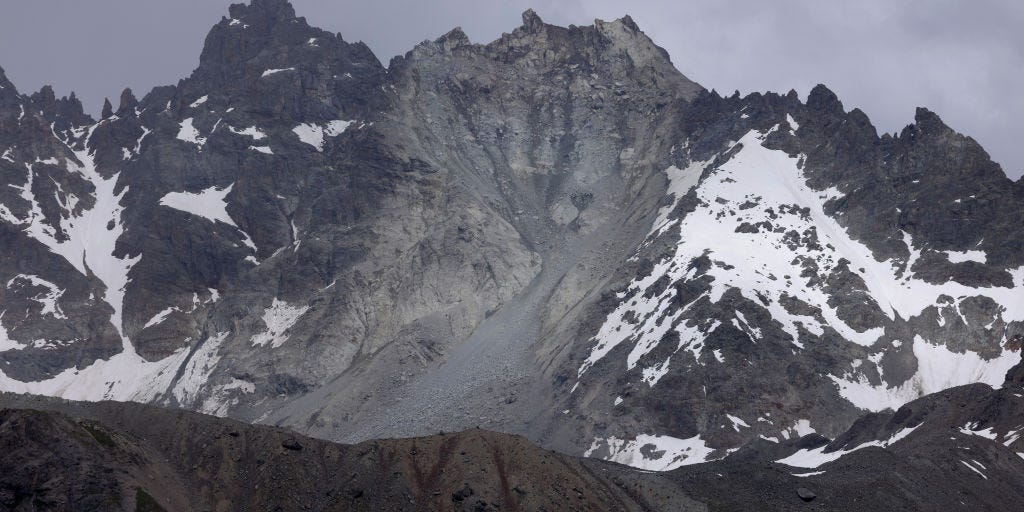Mt. Fluchthorn’s tallest peak, on the Swiss-Austrian border, collapsed in June.
Experts say peaks in the European Alps and Southern Alps of New Zealand are at risk of collapse, too.
The damage and dangers from mountain collapse disproportionately impact indigenous communities.
On June 11, the main peak of Mt. Fluchthorn, on the border of Austria and Switzerland, collapsed without warning.
Roughly 3.5 million cubic feet of earth tumbled down, filling the valley below with 40 Olympic swimming pools’ worth of rocks, mud, and dirt, LiveScience reported. While no people got hurt, a religious cross marking the summit was destroyed.
Fluchthorn had three peaks, and the main, southern one used to be the tallest. With the south peak collapsed, the middle peak is the new summit at 11,145 feet — the second-highest summit in the Silvretta Alps.
Overall, Mt. Fluchthorn is 60 feet shorter than it was earlier this year, per LiveScience.
Why did the peak collapse? Well, like many mountains in the far north, Fluchthorn had a lot of permafrost — a permanent layer of ice and dirt under the mountain’s surface.
“Permafrost is important because frozen water within the ground holds the ground surface together and prevents it from moving. But when that ice melts, the liquid water can flow away. The ground surface becomes less stable and can move, often very quickly,” said Jasper Knight, a geoscientist at the University of Witwatersrand in South Africa.
When a big chunk of mountain moves quickly, like with the mudslide at Fluchthorn, that’s called a mass movement.
“Global warming is causing the permafrost to melt, which is the trigger for these mass movement events to take place,” Knight said.



Am not a farmer but, doesn’t terrace farming lead to soil erosion and lead to more mudslides? Typically because most trees are removed along the mountain sides which would have larger root networks than crops?
A similar issue is going on in china with promotion of terrace farming and crop loss in recent floods.
At this height there are no trees in the alps. There is mostly rock and ice. And when the ice melts the rocks loose their connection or the melting extending ice/water let them crack.
The terrace farming was suggested as solution in south america not the alps. I doubt there is much scope for any farming on the Alps or any similar terrain.
And how exactly would permafrost work in a mostly rocky terrain, unless its very loose small gravely soil. Most tall peaks at those elevations are large contiguous rocks. Its hard to believe those were held together by permafrost. I might be missing some context here.
Not above the tree line, no, most of it is either forestry (carefully) and/or cow pastures though there’s also some crazies up there doing permaculture and growing kiwifruit. I’m not kidding you can do a lot of shit with wind shielding and generally furnishing the terrain to work for you, it’s not that the area lacks sunshine. That’s kind of the problem in a sense isn’t it.
In any case none of that would help stabilising thawing permafrost above the treeline. Pretty much the only thing that can be done short of driving pillars into the ground all over the place is making sure there’s snow cover, if need be artificial, to reflect sunlight.
Those gravelly permafrost areas are either what’s left of glaciers, or otherwise the result of erosion, nothing ever really grew there but lichen and the occasional ridiculously hardy plant, but nothing with any amount of noticeable root system – hence the term “above the tree line”.
They’re very good at managing that kind of stuff in the Alps, the general principle being to let stuff come down (also snowslides etc) but make sure that it’s coming down in a place and at a time where noone gets hurt. You don’t want to fight gravity, not on that scale. They have every corner of those montains mapped and have ages of experience in how things behave.
Like the Rhaetian Railway easily could be the most dangerous railway track in the world due to the absolutely insane terrain it crosses but, well, it’s in Switzerland.
As to the indigenous people: They’re Swiss. Davos can afford to relocate itself.